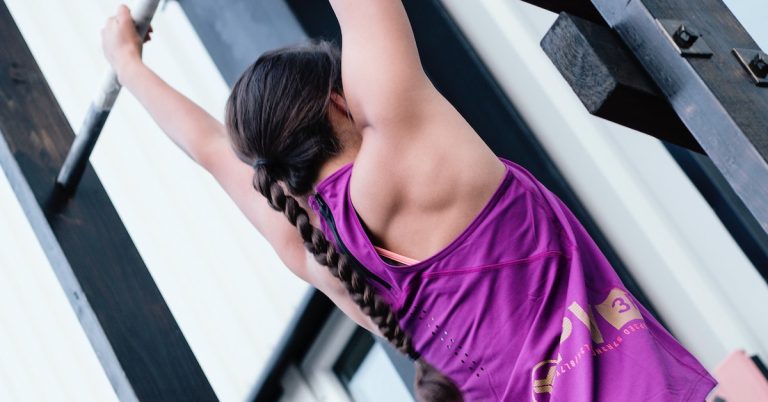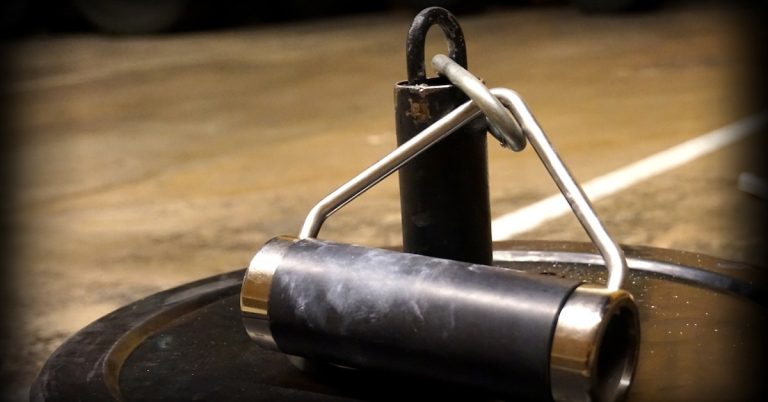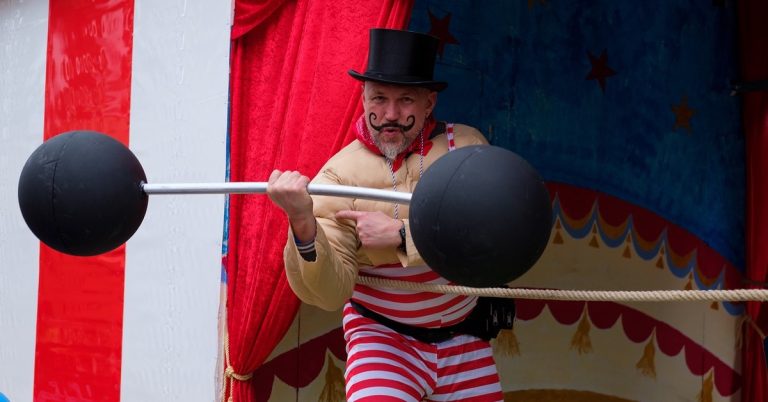In this article, we’ll explore posture improvement through strength training. I won’t bore you with why so-called “ideal” posture is important – you can read my article Woman’s Posture from a Man’s Perspective for that – but I will offer some tips on how to correct so-called “poor” posture.
Corrective exercise should involve movements to lengthen the common short and tight muscles of the calves, hip flexors, chest, shoulders (anterior deltoids), and wrist flexors, and movements to shorten the common long and flaccid muscles of the shins, hip extensors, abdominals, middle back, shoulders (posterior deltoids), and wrist extensors. There are numerous reasons for these postural deviations, from improper footwear (e.g., high heels), to excessive sitting, to hours spent typing, writing, eating, and driving each day, to imbalanced training programs, and so on.
Take a kypho-lordotic posture, for example. This is a common situation where someone has an excessive curve in their upper and lower spine and is often referred to as a hunchback posture. (Kyphosis refers to an outward curve of the spine and lordosis refers to an inward curve of the spine when viewed posteriorly.) I’m sure you see this in many of your clients. Below are two options to address excessive thoracic and lordotic curvatures with strength training. Let’s take a look at the programs first and then we’ll discuss the details.
Option #1 – Staggered Pairing
A1. Dumbbell Step-Ups: 3 x 15-20 @ 1-1-1-1, 60s
A2. Seated Dumbbell External Rotation: 3 x 12-15 @ 3-0-1-0, 60s
B1. Front Split Squat (s): 3 x 6-8 @ 4-1-1-0, 60s
B2. Flat Pronated-Grip Dumbbell Flyes (s): 3 x 12-15 @ 3-1-1-0, 60s
C1. Supine Pelvic Tilt (c): 3 x 15-20 @ 2-0-1-0, 60s
C2. Seated Rope Row to Neck (c): 3 x 12-15 @ 2-0-1-2, 60s
D1. One-Leg Calf Raise (s): 3 x 12-15 @ 2-2-1-0, 60s
D2. Prone Cobra (c): 3 x 10-12 @ 1-0-1-5, 60s
(c) emphasize contracted position (s) emphasize stretched position
Option #2 – Antagonist Pairing
A1. Rear-Foot-Elevated Back Split Squat (s): 3 x 10-12 @ 3-1-1-0, 60s
A2. Supine One-Leg Hip Extension (c): 3 x 10-12 @ 1-0-1-5, 60s
B1. Incline Neutral-Grip Dumbbell Press (s): 3 x 10-12 @ 3-1-1-0, 60s
B2. Prone-Incline Supinated Dumbbell Lateral Raise (c): 3 x 12-15 @ 2-0-1-2, 60s
C1. Standing Calf Raise (s): 3 x 12-15 @ 2-2-1-0, 60s
C2. Seated Tibialis Raise (c): 3 x 15-20 @ 1-0-1-1, 60s
D1. Seated Dumbbell Wrist Curl (s): 3 x 12-15 @ 1-2-1-0, 60s
D2. Seated Dumbbell Reverse Wrist Curl (c): 3 x 12-15 @ 1-0-1-2, 60s
(c) emphasize contracted position (s) emphasize stretched position
These routines should be performed three days a week on non-consecutive days. For example, a Monday/Wednesday/Friday schedule is popular since it frees up the weekend.
Each program consists of four pairs of exercises sequenced in either a staggered fashion (Option #1) or as antagonists (Option #2). As I discuss in my book The Elite Trainer, sequencing exercises in a staggered-pair manner (i.e., alternating between upper and lower body exercises or non-competing movements) is an excellent strategy for body composition purposes to increase lean body mass and decrease body fat. Antagonist (opposite) body part or movement pairing seems to have a greater effect on muscle strength and hypertrophy. So pick your poison and get to it!
You’ll notice that certain exercises emphasize the contracted position and others the stretched position by inserting a 1- to 5-second pause at those portions of the movement. That’s done for a specific reason. Here’s the rationale behind the approach.
To encourage muscle balance, first lengthen the short and tight muscles with static holds under load in the stretched position (consider this a passive stretch), and then follow that up either in the next exercise (antagonist-pairing approach) or the next pair of exercises (staggered-pairing approach) with a static hold in the contracted position to shorten the long and flaccid muscles.
For example, in Option #1 you lengthen the pectorals and anterior deltoids with the flat pronated-grip dumbbell flyes and shorten the middle back and rear deltoids with the seated rope row to neck. In Option #2 you lengthen the hip flexors with the rear-foot-elevated back split squat and shorten the hip extensors with the supine one-leg hip extension. You get the idea!
The notion that weight training will make you inflexible is simply not true. In athletics, Olympic weightlifters are second only to gymnasts in terms of flexibility. Of course, if you constantly train in a limited range of motion (ROM), then you’ll adopt a limited ROM. In most cases, this is not ideal. However, in some cases, it is appropriate. Take the elbow joint, for example. Many novice female trainees will hyperextend at the elbow. For these clients, you should limit their ROM when they perform arm curls. In other words, have them stop just shy of full extension at the bottom. Whereas, many advanced male trainees show the opposite tendency and thus, they should emphasize full ROM during arm curls to allow the weight to passively stretch the elbow flexors in the bottom position. In this manner, you can tailor the exercise to the individual.
Either end of the stability-mobility spectrum is not ideal. Put simply, being too flexible or not flexible enough is not good! Weight training can be used as a tool to promote balance and integrity around any joint.
As rehabilitation specialist Paul Chek is fond of saying: “You adopt the posture you train in!” There’s no doubt that if you train in poor posture, you’ll adopt poor posture. However, when you focus on posture and form during training, good things happen. As a fitness professional, you must emphasize proper form at all times with your clients. Once form breaks, terminate the set. It is much easier to develop good habits than to try and break bad ones, but it doesn’t end there…
If the average client trains three times a week for an hour each time, it represents roughly 1.8% of the week. What happens the rest of the time? If a client trains in absolute “perfect” posture during their one-hour workout and then goes to work and slouches at their desk for another eight hours, what do you think the outcome would be? All the hard work in the gym will be quickly negated by the tendencies at work or home. Therefore, awareness is key!
In the past, we used a little trick of applying some Kinesio tape between the shoulder blades in the morning before leaving for work or school. The second you start to slouch, the tape will quickly remind you. It’s a great proprioceptive cue. The goal is to try to last longer each day with the scapula set properly. The problem with this technique, however, is that you need someone to apply it for you. It’s not always practical.
A new shirt called Adrenalease may be just what the doctor ordered. Consider this body alignment garment as a “wearable exercise” for your posture!
The bottom line is that exercises in the gym can be manipulated to encourage positive changes in posture, but awareness outside the gym is integral to making those changes occur.

The Periodization Blueprint for Chin-Ups and Pull-Ups
Exciting news! Just got my hands on Swissies45, and they’ve transformed my chin-up game. No more draping an EZ-Curl bar

Unleash Your Grip Strength: Elevate Your Performance with IronMind Implements
Are you ready to take your grip strength to the next level? Look no further than IronMind implements. These versatile

The 3/7 Method for Size and Strength
A new strength training protocol has surfaced that will help you maximize strength gains with less training time and effort.
follow
Error: No feed with the ID 2 found.
Please go to the Instagram Feed settings page to create a feed.
